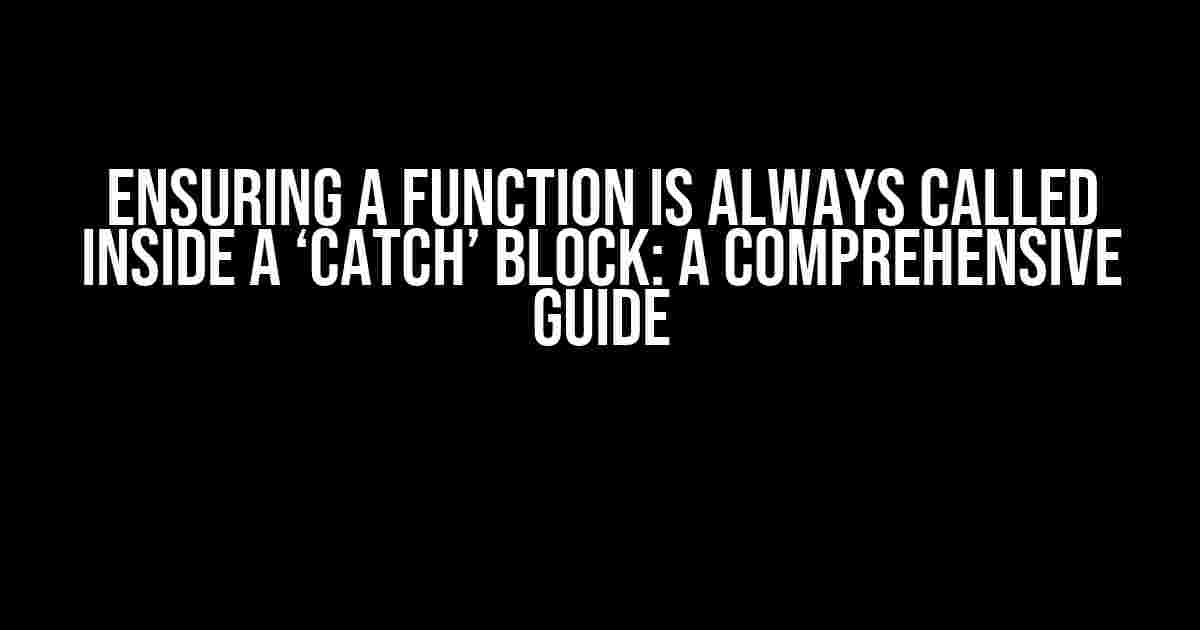One of the most crucial aspects of error handling in programming is ensuring that a function is always called inside a ‘catch’ block. This technique is essential to prevent your application from crashing or malfunctioning when an unexpected error occurs. In this article, we’ll delve into the importance of calling a function inside a ‘catch’ block, explore the different methods to achieve this, and provide hands-on examples to solidify your understanding.
Why is it necessary to call a function inside a ‘catch’ block?
Before we dive into the implementation details, let’s first understand why it’s essential to call a function inside a ‘catch’ block. When an error occurs in your code, it can propagate up the call stack and potentially crash your application if not handled properly. By calling a function inside a ‘catch’ block, you can:
- Prevent your application from crashing or freezing
- Provide a better user experience by handling errors gracefully
- Log and track errors for debugging and analytics purposes
- Perform cleanup operations to release system resources
Methods to ensure a function is always called inside a ‘catch’ block
There are several ways to ensure a function is always called inside a ‘catch’ block, depending on the programming language and framework you’re using. Here are some common methods:
Try-Catch-Finally Blocks
In languages like Java, C#, and Python, you can use try-catch-finally blocks to ensure a function is always called inside a ‘catch’ block. The finally block is executed regardless of whether an exception is thrown or not.
try {
// Code that might throw an exception
} catch (Exception e) {
// Call the function inside the catch block
logError(e);
} finally {
// Always executed, regardless of whether an exception is thrown
cleanupResources();
}
Callback Functions
In JavaScript, you can use callback functions to ensure a function is always called inside a ‘catch’ block. This method is particularly useful when working with asynchronous code.
asyncFunction().then(result => {
// Handle the result
}).catch(error => {
// Call the function inside the catch block
logError(error);
// Always executed, regardless of whether an exception is thrown
cleanupResources();
});
Error Handlers
In some frameworks, such as Node.js, you can use error handlers to catch and handle errors globally. This method ensures that a function is always called inside a ‘catch’ block, even if an error occurs in a callback function or asynchronous code.
process.on('uncaughtException', error => {
// Call the function inside the catch block
logError(error);
// Always executed, regardless of whether an exception is thrown
cleanupResources();
});
Best Practices for Calling a Function Inside a ‘catch’ Block
When calling a function inside a ‘catch’ block, it’s essential to follow best practices to ensure your code is robust and maintainable. Here are some guidelines to keep in mind:
- Keep the catch block concise: Avoid cluttering the catch block with complex logic or multiple function calls. Instead, keep it concise and focused on error handling.
- Use a centralized error handling mechanism: Use a centralized error handling mechanism, such as a logging framework, to handle errors consistently across your application.
- Log errors with context: When logging errors, make sure to include context, such as the error message, stack trace, and relevant variables, to facilitate debugging.
- Implement a clear error handling strategy: Establish a clear error handling strategy, such as retrying failed operations or displaying an error message to the user, to ensure consistency across your application.
Common Pitfalls to Avoid
When calling a function inside a ‘catch’ block, there are several pitfalls to avoid:
| Pitfall | Description |
|---|---|
| Swallowing exceptions | Avoid catching exceptions without taking any action, as this can lead to silent failures and make debugging difficult. |
| Nested try-catch blocks | Avoid using nested try-catch blocks, as this can lead to confusion and make error handling more complex. |
| Over-catching exceptions | Avoid catching too broad of exceptions, as this can mask important errors and make debugging more challenging. |
| Ignoring error context | Avoid ignoring error context, such as the error message and stack trace, as this can make debugging more difficult. |
Conclusion
In conclusion, ensuring a function is always called inside a ‘catch’ block is crucial for error handling and preventative measures in programming. By following best practices, avoiding common pitfalls, and using the methods outlined in this article, you can write robust and maintainable code that provides a better user experience and facilitates debugging. Remember, error handling is not an afterthought, but an essential aspect of software development.
By incorporating the techniques and strategies discussed in this article, you’ll be well-equipped to handle errors with confidence and ensure that your application remains stable and reliable, even in the face of unexpected errors.
Frequently Asked Question
Get answers to your burning questions about ensuring a function is always called inside a ‘catch’ block!
Why is it important to ensure a function is always called inside a ‘catch’ block?
Ensuring a function is always called inside a ‘catch’ block is crucial because it allows you to handle unexpected errors and exceptions that may occur during the execution of your code. This way, you can provide a fallback mechanism to prevent your application from crashing or behaving unexpectedly.
How do I ensure a function is always called inside a ‘catch’ block in JavaScript?
In JavaScript, you can use a try-catch block to ensure a function is always called inside a ‘catch’ block. The basic syntax is: try { // code that might throw an error } catch (error) { // call your function here }. This way, if an error occurs, the function will be called and you can handle the error accordingly.
Can I use a finally block to ensure a function is always called?
Yes, you can use a finally block to ensure a function is always called, regardless of whether an exception is thrown or not. The finally block is executed after the try and catch blocks, so you can place your function call there to guarantee it’s always executed.
What are some best practices for ensuring a function is always called inside a ‘catch’ block?
Some best practices include keeping your try-catch blocks concise and focused on a specific task, avoiding complex logic inside the catch block, and logging errors and exceptions for future debugging. Additionally, consider using a centralized error handling mechanism to keep your code organized and maintainable.
Are there any trade-offs to ensuring a function is always called inside a ‘catch’ block?
Yes, there are trade-offs to ensuring a function is always called inside a ‘catch’ block. For example, it can lead to code bloat and increased complexity, which can make your code harder to maintain. Additionally, overusing try-catch blocks can mask underlying issues and make debugging more challenging.


